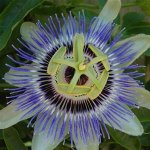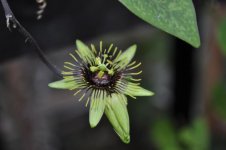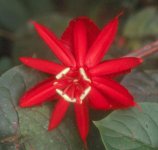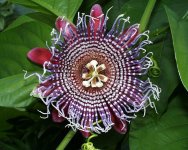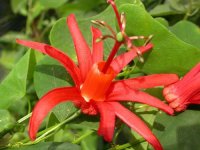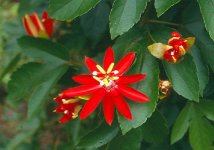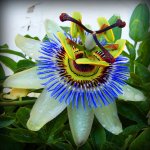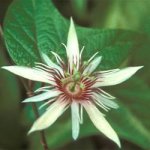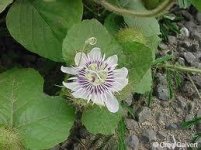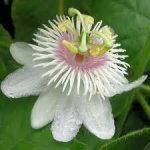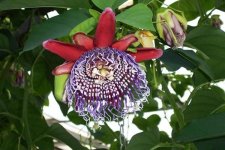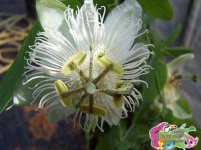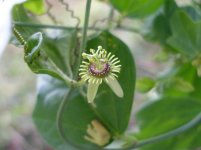..from researching the MAOI effects of various flavonoids, i am inspired to start a Passiflora thread.. some contain useable amounts of harmala alkaloids, but much of the sedative/action of these species is due to flavonoids..more on this later.
..northern hemispherians can perhaps bask in warm notions of growing some next spring..in fact some of the biggest collections of grown world-wide passifloras are in Germany and the Netherlands..
the following list is taken mainly from Voogelbreinder (2009), which has an excellent passiflora section, there are around 600 species worldwide found mostly in C. and S. America & the Caribbean, with a few in N. America, Africa, the Pacific & Australia..symbiotic butterflies who graze them also contain similar harmala alkaloids..one species (Passiflora xiikzodz)is known only from mayan temple ruins..
Passifloras containing Harmala alkaloids or known to be sedative/psychoactive:
P. actinia
P. alata (Wing-stemmed Passionflower)
P. alba (White Passion Vine)
P. biflora (Two-flowered Passionflower)
P. byroniodes (‘cocapitos’)
P. caerulea (Blue Passionflower)
P. capsularis (‘calzoncillo’)
P. coccinea (Red Passionflower)
P. costaricensis
P. x decainseana
P. edulis (Common Passionfruit - several varieties)
P. eichleriana
P. foetida (Stinking Passionflower)
P. hibertiana
P. incarnata (Passionflower herbal)
P. involucrata (‘chontay huasca’)
P. jorullensis (‘coanenepilli’)
P. ligularis
P. mollissima (Bannana Passionfruit)
P. murucuja (Dutchman’s Laudanum)
P. oerstedii
P. quadrangularis (Giant Granadilla)
P. quitensis
P. rubra (Dutchman’s Laudanum)
P. suberosa (Cork-barked Passionflower)
P. supbeltata
P. vespertilio (Bat-winged Passionflower)
P. warmingii
(28 in total. so far)
i’ll look at each one in more detail soon..it is known that p. incarnata can be used to orally activate tryptamines (see Harmine In Passiflora Caerulea -)..there are other possibilities awaiting discovery..
..anyone with Passiflora knowledge’ s input is much appreciated (be it growing them, wild sightings, medicinal use, or chemistry reports)
.
below is the herbal medicinal ‘passionflower’ Passiflora incarnata, native southern USA (though the flowers are not actually the part used for anti-depressant/sedative effects, except perhaps visually);
and below that is Passiflora xiikzodz, a presumed Mayan cultivar...
..northern hemispherians can perhaps bask in warm notions of growing some next spring..in fact some of the biggest collections of grown world-wide passifloras are in Germany and the Netherlands..
the following list is taken mainly from Voogelbreinder (2009), which has an excellent passiflora section, there are around 600 species worldwide found mostly in C. and S. America & the Caribbean, with a few in N. America, Africa, the Pacific & Australia..symbiotic butterflies who graze them also contain similar harmala alkaloids..one species (Passiflora xiikzodz)is known only from mayan temple ruins..
Passifloras containing Harmala alkaloids or known to be sedative/psychoactive:
P. actinia
P. alata (Wing-stemmed Passionflower)
P. alba (White Passion Vine)
P. biflora (Two-flowered Passionflower)
P. byroniodes (‘cocapitos’)
P. caerulea (Blue Passionflower)
P. capsularis (‘calzoncillo’)
P. coccinea (Red Passionflower)
P. costaricensis
P. x decainseana
P. edulis (Common Passionfruit - several varieties)
P. eichleriana
P. foetida (Stinking Passionflower)
P. hibertiana
P. incarnata (Passionflower herbal)
P. involucrata (‘chontay huasca’)
P. jorullensis (‘coanenepilli’)
P. ligularis
P. mollissima (Bannana Passionfruit)
P. murucuja (Dutchman’s Laudanum)
P. oerstedii
P. quadrangularis (Giant Granadilla)
P. quitensis
P. rubra (Dutchman’s Laudanum)
P. suberosa (Cork-barked Passionflower)
P. supbeltata
P. vespertilio (Bat-winged Passionflower)
P. warmingii
(28 in total. so far)
i’ll look at each one in more detail soon..it is known that p. incarnata can be used to orally activate tryptamines (see Harmine In Passiflora Caerulea -)..there are other possibilities awaiting discovery..
..anyone with Passiflora knowledge’ s input is much appreciated (be it growing them, wild sightings, medicinal use, or chemistry reports)
.
below is the herbal medicinal ‘passionflower’ Passiflora incarnata, native southern USA (though the flowers are not actually the part used for anti-depressant/sedative effects, except perhaps visually);
and below that is Passiflora xiikzodz, a presumed Mayan cultivar...

